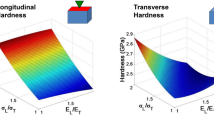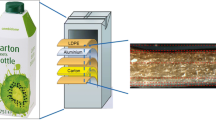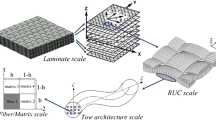Abstract
To model advanced 3-D forming strategies for paper materials, the effects of environmental conditions on the mechanical behavior must be quantitatively and qualitatively understood. A tensile test method has been created, verified, and implemented to test paper at various moisture content and temperature levels. Testing results for one type of paper for moisture contents from 6.9 to 13.8 percent and temperatures from 23 to 168 degrees Celsius are presented and discussed. Coupled moisture and temperature effects have been discovered for maximum stress. Uncoupled effects have been discovered for elastic modulus, tangent modulus, hardening modulus, strain at break, tensile energy absorption (TEA), and approximate plastic strain. A hyperbolic tangent function is also utilized which captures the entire one-dimensional stress-strain response of paper. The effects of moisture and temperature on the three coefficients in the hyperbolic tangent function may be assumed to be uncoupled, which may simplify the development of moisture- and temperature-dependent constitutive models. All parameters were affected by both moisture and temperature with the exception of TEA, which was found to only be significantly dependent on temperature.














Similar content being viewed by others
References
Östlund M, Borodulina S, Östlund S (2011) Influence of paperboard structure and processing conditions on forming of complex paperboard structures. Packag Technol Sci 24:331–341
Hauptmann M, Majschak J P (2011) New quality level of packaging components from paperboard through technology improvement in 3D forming. Packag Technol Sci 24:419–432
Vishtal A, Retulainen E (2012) Deep-drawing of paper and paperboard: the role of material properties. BioResources 7(3):4424–4450
Groche P, Huttel D, Post PP, Schabel S (2012) Experimental and numerical investigation of the hydroforming behavior of paperboard. Prod Engineer 6:229–236
Huang H (2010) A simplified material model for finite element analysis of paperboard creasing. Nord Pulp Pap Res J 25(4):505–512
Xia Q S, Boyce M C, Parks D M (2002) A constitutive model for the anisotropic elastic-plastic deformation of paper and paperboard. Int J Solids Struct 39:4053–4071
Mäkelä P, Östlund S (2003) Orthotropic elastic-plastic material model for paper materials. Int J Solids Struct 40:5599–5620
Yokoyama T, Nakai K (2006) Tensile stress-strain properties and fracture resistance of paper and paperboard. In: Conference and exposition on experimental and applied mechanics, SEM annual
Land C, Wahlström T, Stolpe L, Beghello L (2010). Nord Pulp Pap Res J 25(4): 481–487
Yeh K, Considine J, Suhling J (1991) The influence of moisture content on the non-linear constitutive behavior of cullulosic materials. In: Conference on international paper physics, pp 695–711
Haslach H.W. (2000) The moisture and rate-dependent mechanical properties of paper: A review. Mech Time-Depend Mat 4:169–210
Haslach H (2009) Time-dependent mechanisms in fracture of paper. Mech Time-Depend Mat 13:11–35
Gunderson D, Considine J, Scott C (1988) The compressive load-strain curve of paperboard: rate of load and humidity effects. J Pulp Paper Sci 14:713–726
Nissan A H (1976) H-bond dissociation in hydrogen bond dominated solids. Macromolecules 9(5):840–850
Erkkilä A.L., Leppänen T, Hämäläinen J (2013) Empirical plasticity models applied for paper sheets having different anisotropy and dry solids content levels. Int J Solids Struct 50:2151–2179
Benson R E (1971) Effects of relative humidity and temperature on tensile stress-strain properties of kraft linerboard. Tappi J 54(5):699–703
Ek M, Gellerstedt G, Henriksson G (2009) Paper Products Physics and Technology, Pulp and Paper Chemistry and Technology, vol. 4, chapter 4, pp. 109–143. De Gruyter, Berlin
Berthold J, Desbrières J, Rinaudo M, Salmén L (1994) Types of adsorbed water in relation to the ionic groups and their counter-ions for some cellulose derivatives. Polymer 35(26):5729–5736
Luukkonen P, Maloney T, Rantanen J, Paulapuro H, Yliruusi J (2001) Mircrocrystalline cellulose-water interaction – a novel approach using thermoporosimetry. Pharmaceut Res 18(11):1562–1569
Salmėn N L, Back E L (1977) Simple stress-strain measurements on dry papers from -25 ∘c to 250 ∘c. Sven Papperstidn 80(6):178–183
Salmén N L, Back E.L. (1978) Effect of temperature on stress-strain properties of dry papers. Sven Papperstidn 81(10):341–346
Salmén N L, Back E L (1980) Moisture-dependent thermal softening of paper evaluated by its elastic modulus. Tappi J 63(6):117–120
Hagman A (2012) Nygårds, M. Nord Pulp Pap Res J 27(2):295–304
Gunderson D (1991) Method for measuring mechanosorptive properties. J Pulp Pap Sci 17(2):J53—J59
Borodulina S, Kulachenko A, Galland S, NygÖÖårds M (2012). Stress-strain curve of paper revisited. Nordic Pulp and Paper Research Journal 27(2):318–328
Isaksson P, Gradin P, Kulachenko A (2006) The onset and progression of damage in isotropic paper sheets. Int J Solids Struct 43:713–726
Coffin D W (2012) Use of the efficiency factor to account for previous straining on the tensile behavior of paper. Nordic Pulp Pap Res J 27(2):305–312
Acknowledgements
The authors would like to acknowledge and thank BiMaC Innovation and its industrial partners for their financial support of this research. Additionally, the authors would like to thank Per Larsson and the Department of Fibre and Polymer Technology at KTH Royal Institute of Technology for their assistance with preparing the handsheets and Magnus Gimker and Innventia for their assistance with pulp beating.
Author information
Authors and Affiliations
Corresponding author
Appendices
Appendix A: Moisture Loss Analysis
Utilizing the results presented in Fig. 3, the amount of moisture loss at each tested environmental condition can be extrapolated as shown in Table 6. Each value in Table 6 represents the maximum amount of moisture loss at that respective test condition. The values for 23 degrees Celsius at all moisture contents and values for 168 degrees Celsius at 6.9 and 13.9 % moisture content represent maximum moisture losses which are known either from Fig. 3 or from the fact that tests without temperature application should retain constant moisture, while the values were linearly extrapolated from the known results.
The moisture loss during the tests should be greatest for the failure properties, so the effect of the moisture loss on the maximum stress and strain at break results are investigated. The maximum stress results with the adjustments presented in Table 6 are shown in Fig. 15. The results displayed in Fig. 15 show that the coupled effects of moisture and temperature are still present. The trends have not changed drastically compared to Fig. 11.
The results of the strain at break considering the adjustments in Table 6 are displayed in Fig. 16. The results in Fig. 16 appear to indicate the same trends as the results without correction for moisture loss in Fig. 12. While the moisture loss has some impact on the results, the trends and appearance of coupling do not appear to be considerably affected by the loss of moisture.
Determining the actual amount of moisture loss during each test would be difficult and require many assumptions. Therefore, not adjusting for moisture loss is determined to be the least biased method to present the experimental results. The results which are not corrected for moisture loss are assumed to capture the trends and coupling of the effects of moisture and temperature on each parameter.
Appendix B: Measurement Error Analysis
Sources and magnitudes of possible measurement error are displayed in Table 7. Utilizing the first five possible measurement errors (displacement, force, width, thickness, and test length) in Table 7, estimates of the error induced into the numerical results caused by the test measurement system can be analyzed for each load case. The results of these analyses are displayed in Table 8. The maximum effects of the possible measurement error on each parameter as well as the measurements which dominate the errors are presented in Table 8. The errors on the three curve-fitting parameters for the hyperbolic tangent function (C 1, C 2 and C 3) are not presented, because determining the maximum measurement error on those parameters is not trivial. Additionally, the maximum error for those parameters is expected to be approximately the same magnitude as the errors presented in Table 8.
The thickness of paper sheets varies considerably, especially in hand sheets like the ones utilized in this study. This thickness variation causes the greatest measurement error throughout the results. The other two factors which dominate the error magnitude are the specimen length and the strain range utilized in calculating the tangent modulus. The specimen length was limited by the temperature application method, while the strain range was limited by the length of the hardening regions (i.e. the region during which both reversible and irreversible straining occurs) for specimens with a small plastic straining region. Reducing these sources of measurement error would be difficult given the requirements of the temperature application method and given the testing condition at high temperature and low moisture content.
The errors in Table 8 are expected only in worst-case scenarios, so actual error values much less than these are expected. Therefore, the results should not be significantly affected by the possible measurement errors.
Table 8 does not take into consideration the potential moisture loss and the temperature error. The moisture content and temperature changes according to Table 7 would cause shifts along the horizontal axis for the figures presented in the results section of this paper, while the errors in Table 8 would cause shifts along the vertical axis for those figures.
Rights and permissions
About this article
Cite this article
Linvill, E., Östlund, S. The Combined Effects of Moisture and Temperature on the Mechanical Response of Paper. Exp Mech 54, 1329–1341 (2014). https://doi.org/10.1007/s11340-014-9898-7
Received:
Accepted:
Published:
Issue Date:
DOI: https://doi.org/10.1007/s11340-014-9898-7






